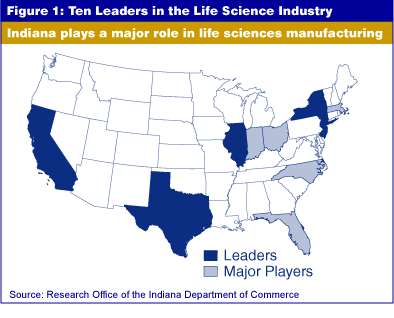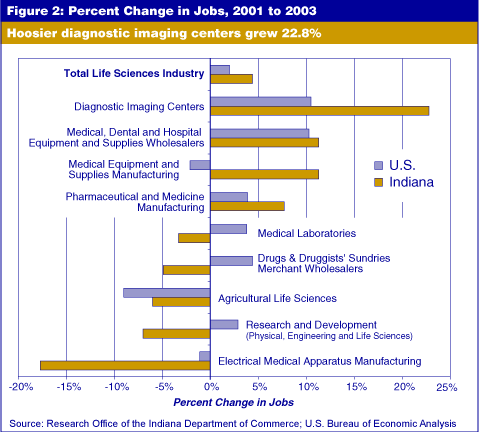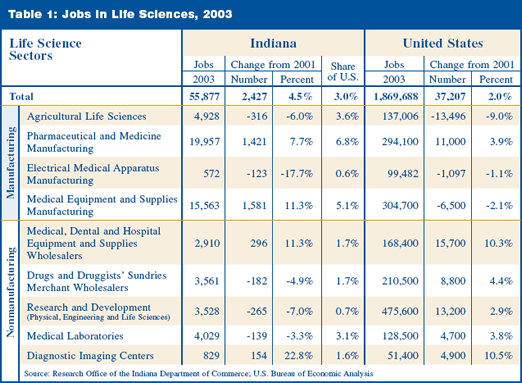Life Sciences in Indiana: Current Trends by Sector
Life science is one of four targeted industries in Indiana. Using the Biotechnology Industry Organization’s (BIO) guidelines, Indiana is part of an important group of life science states (see Figure 1).

Indiana’s strength is in life science manufacturing with 4.9 percent of the U.S. jobs and a 6.7 percent job growth since 2001 compared to a 1.2 percent national decline, using 2003 preliminary data (see Table 1).
Indiana is outperforming the U.S. in the pharmaceutical and medicine and medical equipment and supplies sectors (see Figure 2). Since 2001, Indiana jobs in medical equipment and supplies increased 11.3 percent (1,500 jobs) compared to a U.S. decline of 2.1 percent. During this period, Indiana accounted for one in eight net jobs added to national pharmaceutical and medicine employment.

Although jobs in the agricultural-related sector declined in Indiana, on a percentage basis, it was approximately one-third less than the national rate of decline. Indiana’s electrical medical apparatus sector showed the most significant decline on a percentage basis. However, Indiana’s share of this sector is small because the industry is highly concentrated in a few states (with nearly a quarter of all jobs in California).
Since 2001, Indiana experienced a slight decline in nonmanufacturing life science jobs (-0.9 percent) while the nation grew 4.8 percent. It should be remembered, however, that agreement on what constitutes this sector is subject to debate and a considerable amount of research activity and jobs are not captured by the NAICS codes used to define life sciences. Life science research conducted by Eli Lilly, Purdue and Indiana Universities and various Indianapolis hospitals would be reported under codes for manufacturing, education and hospitals, respectively. Even if these data were available, however, it is likely that Indiana would still be underperforming in most nonmanufacturing life science sectors.
Life Sciences Rankings
To get detailed rankings for all states, 2002 benchmarked data was used. There may be slight differences in Indiana’s share of U.S. jobs from the preliminary 2003 data, but relative rankings will show little change.
- Starch and Vegetable Oil Manufacturing: Led by companies such as A.E. Staley, Cargill, Central Soya and National Starch, Indiana ranks third.
- Ethyl Alcohol Manufacturing: With so little information available, it is difficult to determine the significance of Indiana’s share of the nation’s jobs. Since no state has a concentration, if synthetic fuels ever become common, Indiana will be on an equal footing.
- Agricultural Chemicals: Indiana ranks seventh in agricultural chemical manufacturing (fertilizers and pesticides) with a 5.6 percent share of U.S. jobs, but has few jobs in other basic organic chemical manufacturing.
- Pharmaceutical Manufacturing: Indiana ranks seventh in the combined pharmaceutical and medicine manufacturing sector and ranks fifth when pharmaceuticals is ranked alone. Pharmaceutical and medicine manufacturing is made of four sectors (pharmaceuticals plus three other small sectors), and while the three other sectors are small to begin with, Indiana’s difference in ranking illustrates that Indiana has very few jobs in them. These sectors are involved with manufacturing and processing uncompounded botanicals, producing substances used in diagnostic testing and manufacturing. It may be that Eli Lilly has a number of jobs involved in these three sectors, but reporting procedures include them in pharmaceutical manufacturing.
- Electromedical Manufacturing: Only a handful of states have more than 1,000 jobs in any of these sectors. For example, Utah ranks fourth in irradiation apparatus with fewer than 1,000 jobs. Some Hoosier companies are more involved in producing components for electromedical equipment than the final product. Unfortunately, there is no parts sector for electromedical equipment, so determining its exact size and importance is not possible.
- Medical Equipment and Supplies Manufacturing: This is a complex sector producing a wide range of products, including hospital furniture, contact lenses, dental equipment, surgical tools and orthopedic devices. Indiana excels in the larger surgical instruments and appliance sectors, ranking fifth in both categories. While many states saw job declines during the last recession, Indiana continued to experience job growth in both sectors. This growth has been steady over the past decade and there is no reason that Indiana’s rankings in these areas should not continue to climb.
- Distribution: The job performance of Indiana’s life sciences distribution sectors presents something of a mystery. Even considering the fact that many wholesale operations locate near their customers, Indiana’s jobs as a share of the United States is below the state’s share of the national population. The fact that Indiana is a major producer of medical equipment only adds to the mystery. The importance of this sector is best illustrated by wages. The average annual U.S. wage for the wholesale sector in 2002 was $49,241, while it was $62,858 for medical equipment wholesalers and $70,083 for druggists’ goods wholesalers.
- Physical, Engineering and Biological Research: Indiana’s job ranking in this sector is well behind the leaders. The difficulty in using this ranking is that this sector includes non–life sciences research areas, such as engineering, electronics, mathematics, forestry and oceanography. With the recent emphasis being given to research, however, job growth in this sector may attract considerable attention, even if the growth is not life science oriented.
- Medical and Diagnostic Laboratories: This is another
sector that may be driven by population levels; but since Indiana ranks above
its share of the population, it suggests more than population is driving
job levels. It must be remembered that many hospitals and other medical providers
outsource their tests and diagnostic services. With increasing Internet capabilities,
outsourcing of these types of services will be increasing.
Ted Jockel
Senior Economist, Indiana Department of Commerce

